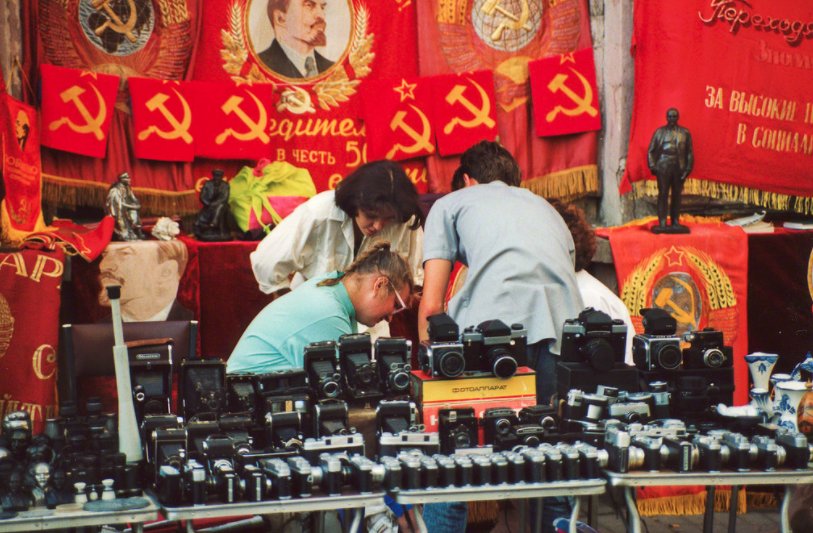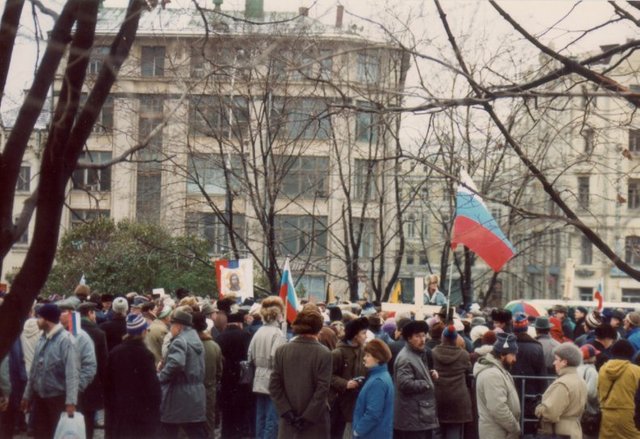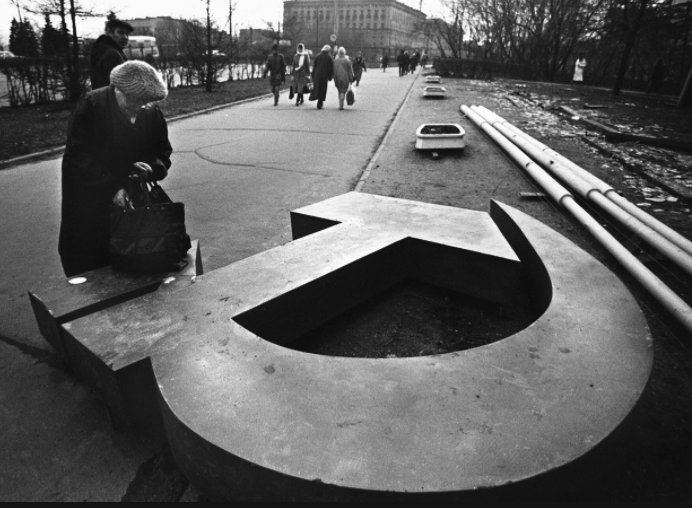
The planned economy of the Soviet Union was based on state ownership of the means of production, centralized administrative planning, heavy industry, and collective farming (called kolkhoz). Five-year plans were produced by Gosplan, an economic administrative institution that planned both input of resources and output of the products across sectors with the help of its vast administrative structure consisting of departments, councils, experts, etc. It was the planning agency of economy in USSR and had also the mandate to monitor its implementation.
Five-year plans guided the domestic production in the Soviet Union from 1928 till its collapse in 1991. An agrarian society turned into a large manufacturer of weaponry and heavy industrial goods, but experiencing shortage of consumer goods. The inefficiency of the planned economy surfaced in the stagnation period during Leonid Brezhnev's leadership in the 1970s. The annual economic growth was lower than in 1960s and expenditures related to the weaponry production exhausted domestic resources (Gunder 1993/1994).
PERESTROIKA AND GLASNOST: A WIND OF A CHANGE
The economic decline of the USSR was inherited by Mikhail Gorbachev who became General Secretary of the Communist Party in 1985. He initiated reforms that aimed to ease the central control of the economy and politics at the same time. These reforms all-together were referred to as perestroika, literally meaning: restructuring. Economic reforms during perestroika radically modified central planning and allowed state enterprises to determine their input of resources considering their need of production, consumers, and other enterprises rather than having Gosplan giving them detailed plans on their economic activities. Yet, Gosplan retained the power of providing general guidelines and national investment priorities. In 1988 the Law on Cooperatives also introduced a new economic structure in the USSR, in the form of private ownership of businesses in foreign-trade, services, and manufacturing.
This reform was very important in eliminating state monopoly on economic activities in various spheres, allowing private owners to emerge and even engage in international trade. Moreover, foreign investors were allowed to invest in the USSR in joint ventures along with state enterprises, ministries, and cooperatives (Gunder 1993/1994). During those major changes introduced by Gorbachev, glasnost brought more openness and transparency of government activities; more freedom of information and speech. The major economic reforms during perestroika needed public support and glasnost was aimed to generate support by providing more freedom. What glasnost and perestroika was not aimed to bring about was what in fact followed. After six years of Gorbachev's rule the Soviet Union dissolved in December 1991. (Read: “Reform, Coup and Collapse: The End of the Soviet State”)
On the ruins of the USSR fifteen republics emerged as independent states. The former republics, except the Baltic States which from the very beginning took a pro-Western political route, decided to form the Commonwealth of Independent States – a union of post-Soviet republics created in December 1991. Georgia was the last to join in 1993.
SHOCK THERAPY AND GRADUALISM
Economic reforms in the post-Soviet states were aimed to move from planned economy to capitalism. During this process two models of economic restructuring were offered: one, known as Shock Therapy (also known as 'big bang') and another one, gradualism.
While all agreed on the need for reform, Shock therapy proponents supported quick and radical changes which would initially result in the declining of livelihoods and production output, but it was argued that those processes would soon diminish and the economy would start functioning well under the free-market environment (Popov 2000).

The Shock therapy model of economic reforms was first initiated in Latin America. It was promoted in the post-Communist space by foreign economic advisors, among which was the Harvard University Professor of Economics, Jeffrey Sachs. A prominent proponent of the shock therapy model of reform in post-Communist states was the Former Deputy Prime Minister of Poland, Leszhek Balcerowicz (Read: “Shock Therapy: Bolivia, Poland, Russia. Same Policies-Different Results”, for a summary of the debate).
Problematizing this approach, a recent study published by the British medical journal "The Lancet," stated that shock therapy with massive privatizations could in fact account for the high-rate of adult mortality in post-Soviet states (see “Mass Privatization Linked To Higher Death Rate In Postcommunist Transition”. For a critique of this statement and a re-examination of the argument see The Economist (Jan 22nd, 2009)).
Gradualists believed that economic reforms had to procede slowly and gradually. State control and regulations were seen as an important aspect of economic reforms and success in some countries where planned economies were liberalized, such as China (Popov 2000). Gradualists argued that the downside of economic reform that leads to reduction of output, unemployment, and a growing level of poverty could be reduced so that the social costs of the reforms were not too high. Gradualists were backed by the prominent scholar and critic of the 'shock therapy' model, Josephe Stiglitz (Read: “Transition Economies”, in the Concise Encyclopedia of Economics).

POST-SOVIET ECONOMIC REFORMS
Upon the demise of the Soviet Regime the post-Soviet countries started massive reforms of the economy as well as the political arena. They had to form institutions and go through accelerated democratization and market-formation processes. Meanwhile they also had to build states. Thus, market-making and state-making in post-Soviet republics was a simultaneous process (Bruszt 2002). During those reforms the post-Soviet republics were assisted financially as well as with know-how (i.e. policy experts and consultants providing their knowledge) and monitored by international monetary institutions (IFIs), such as International Monetary Fund and the World Bank. The former engaged in restructuring the economy and fiscal policy of the states, including monetary policy, privatization, and price liberalization. The latter was more concerned with reforming regulative systems in the states and promoting private sectors across them. The focus of both, though, was for a micro-economic sound policy to be in place in the reforming countries so that the funding of economic reforms would continue and lead to the outcome of a free market economy.
The early transition period in fact did result in hyperinflation, a decline in production output and economic growth, and increased unemployment (Åslund et al. 1996). One of the biggest challenges of the post-Soviet economies was to harness inflation which was high in the early transition period. Tax collection was also low and the states suffered from state budget deficits. Meanwhile price liberalization was taking place slowly. Economic elites which had access to state assets were not willing to let full liberalization take place, as they were reaping sky-rocketing profits from buying assets and natural resources at low prices while the state was still controlling the prices, and selling them at market prices abroad. In fact, some claimed that the early transition was distorted and underwent incomplete reformation due to early winners of the reform processes – the economic elite (Hellman 1998; Havrylyshyn and Odling-Smee, 2000).
Privatization of state-owned assets in post-Soviet states was done through distributing vouchers to the population which made them owners of shares of state property. However, this method of did not lead to private ownership on a larger scale through privatization. In the midst of growing unemployment and poverty, economic elites managed to buy out vouchers from the population either by the exchange of food products or by giving some cash (Exeter and Fries, 1998).
Nonetheless, privatization did in fact lead to state ownership limitation and private sector development across post-Soviet states. Slowly foreign investment also started to flow in those countries and international trade increased, particularly for countries rich in natural resources, such as gas and oil. Some observed that natural resource-rich countries in the post-Soviet area developed characteristics of petrol-states, where the economy is no longer diversified but heavily depends on the export of natural resources (Sabonis-Hef 2004). Some argue that Azerbaijan, Russia, Kazakhstan, and Turkmenistan have had non-transparent state institutions, weak bureaucracies, weak state capacity and an incomplete budget system (Sabonis-Hef 2004:164). These characteristics were shared by OPEC states which have failed to develop democratic states regardless of the windfall of oil and gas export revenues. Meanwhile petrol-state relevant symptoms of overspending on the budget to increase the social security system in a strong presidential system as in Turkmenistan and Kazakhstan are argued to account for the chronic budget deficit as well (Sabonis-Hef 2004:162).
Two decades after the economic reforms in post-Soviet countries started the result vary greatly across countries in terms of their achievements to form free market economies. However, the twelve states (excluding the Baltic States, which were quick reformers and managed to join the EU and NATO soon after the millennium) have achieved significant economic development in terms of GDP growth, harnessing inflation, and attract foreign direct investment.
References:
Åslund, Andres; Peter Boone; Simon Johnson; Stanley Fischer; and Barry W. Ickes. (1996). 'How to Stabilize: Lessons from Post-Communist Countries'.Brookings Papers on Economic Activity, Vol. 1996, No. 1., pp. 217-313.
Boockmann, Bernhard & Dreher, Axel, 2002. "The Contribution of the IMF and the World Bank to Economic Freedom," ZEW Discussion Papers 02-18, ZEW - Zentrum für Europäische Wirtschaftsforschung / Center for European Economic Research
Bruszt, Laszlo. (2002). ‘Market making as state making: Constitutions and economic development in post-communist Eastern Europe.’ Constitutional Political Economy, Volume 13, No 1, 53-72,
Exeter, Juliana and Steven Fries. (1998) 'The Post-Communist Transition: Patterns and Prospects'. Finance and Development, IMF Quarterly Magazine, Vol. 35, Nr. 3.
Gunder, Frank Andre. (1993/1994). 'What Went Wrong in the "Socialist" East?' http://www.rrojasdatabank.info/agfrank/what_went_wrong.html
Havrylyshyn, Oleh and John Odling-Smee. (2000). 'Political Economy of Stalled Reforms'. Finance and Development, IMF Quarterly Magazine, Vol. 37, Nr. 3;
Hellman, Joel S. (1998). 'Winners Take All: The Politics of Partial Reform in Postcommunist Transitions'. World Politics - Volume 50, Number 2, January, pp. 203-234
Popov, V. 2000: Shock therapy versus gradualism: The end of the debate (explaining the magnitude of the transformational recession). Comparative Economic Studies 42(1): 1–57.
Sabonis-Hef, Theresa (2004). ‘The Rise of the Post-Soviet Petro-States: Energy Exports and Domestic Governance in Turkmenistan and Kazakhstan, pp. 159-184, In: Burghart D. and Sabonis-Helf T. (eds). In the Tracks of Tamerlane: Central Asias Path. Washington, DC: National Defense University, Center for Technology and National Security Policy.
Another excellent article, your ability to study all these intricacies amazes me. I was a child when both "glasnost" and "perestroika" was introduced by Mikhail Gorbachev in Soviet Union. He became very popular in the Western world. He was the only Soviet Leader I knew in my childhood. But, he was not popular in Soviet Union and that was proved after the fall of the Union. The Liberal supported Boris Yeltsin, while the communist blaming him for the fall of the Soviet Union, kept him (Gorbachev) at a distance. Now it doesn't seem that he will be popular again. As far as the countries of the Bloc are concerned they either depended on their natural resources for their survival or weapons manufacturing was other source of income. Valdimir Putin through different Business Fair tried to diversify the industries, but succeeded to a limited extent. Telecom and Diamond Cutting are two other industry Russia has had to some extent other than Weapon Manufacturing and Natural Resource Industry.
Downvoting a post can decrease pending rewards and make it less visible. Common reasons:
Submit
Yes thank you for the feedback and personal insight. I always found the history of the Soviet Union and Russia particularly interesting. When I took a course in Russian literature and culture and I always found the richness reflective of historical change. Gorbachev was indeed popular due to his pivot towards what appeared at the time, where Western ideals centered around more open and transparent economic reforms as well as some of the cultural and social changes he implemented. Of course, like contemporary times, resource exploitation seems to be the principle goal of foreign policy. This was principle in the US excursions in Latin America and is being mirrored today in the middle east and I assume is all part of the Grand Strategy that influential academics like Kissinger and Brzezinski extol.
Downvoting a post can decrease pending rewards and make it less visible. Common reasons:
Submit
I salute your exemplary knowledge of the subject. And am also grateful to you for answering me on my comments. You are simply the best person to continue writing on this subject as you also have taken a course on Russian literature and culture. I for one am just a enthusiast and therefore, forgive me if i go wrong somewhere.
Downvoting a post can decrease pending rewards and make it less visible. Common reasons:
Submit